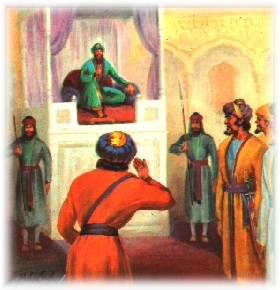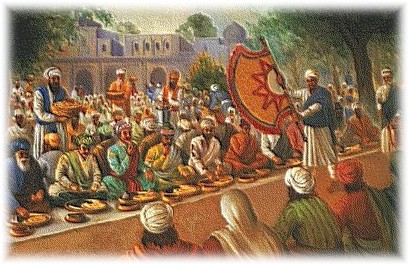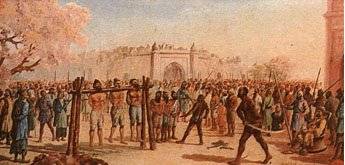
Nawab Kapur Singh Virk (1697-1770)
Massacre in Delhi of Banda Singh Bahadur and his 700 Singhs was followed by severe action against Sikhs. But every fresh adversity only stimulated their will to survival. A commanding figure who led Sikhs through this dark period was Nawab Kapur Singh, the founder of Dal Khalsa. Kapur Singh by his bold example and his wise leadership, welded the Sikhs into a strong fighting force and implanted in their minds the vision of political sovereignty. He was a true embodiment of Sikh character forged by the alchemy of a fiery ordeal and enjoyed unique esteem for his courage, sacrifice and religious devotion.

Nawab Kapur Singh was born of a Virk family of Jats in 1697. His native village was Kalo-ke, now in Sheikhupura district, in Pakistan Punjab. Later, when he seized the village of Faizullapur, near Amritsar, he renamed it Singhpura and started living there. He is also known to history as Kapur Singh Faizullapuria, and the small principality he founded as Faizullapuria's or Singhpuria's state.
Kapur Singh was eleven years old at the time of Guru Gobind Singh's death and nineteen at the time of the massacres Banda Bahadur and his 700 Singhs in Delhi. He had thus passed his early life in an atmosphere charged with the fervor of faith and sacrifice. He came in living tough with the new impulse animating his people when he took baptism at a large gathering of Sikhs held at Amritsar on the occasion of Baisakhi of 1721. Bhai Mani Singh who had been sent to Amritsar as head priest of the Harimandir by Guru Gobind Singh's widow, Mata Sundari ji, conducted the ceremony. Kapur Singh's youthful heart was fired with a new enthusiasm. His father, Dalip singh, and brother, Dan singh, were also among those who were baptized into the Khalsa fold on that historic date

Kapur Singh's physical courage and warlike spirit were valuable qualities in those days of high adventure. He soon gained a position of eminence among his people who were then engaged in a desperate struggle against the Mughal government. Zakariya Khan, Who became the governer of Lahore in 1726, launched a still severer policy against the Sikhs and let loose terror upon them.
Kapur singh headed a band of warriors who, with a view to paralysing the administration and obtaining food for their companions forced to seek shelter in remote hills and forests, attacked government treasuries and caravans moving from one place to another. Such was the effect of their depradations that the governer was soon obliged to make terms with them.
In 1733, the Mughal government decided, at the instance of Zakariya Khan, to lift the quarantine forced upon the Sikhs and made an offer of a grant to them. Offering their leader a title of Nawab and a jagir consisting of paraganahs of Dipalpur, Kanganval and Jhabal.

After some mutual discussion Sikhs accepted the offer. All eyes centered on him and he was, with one accord, selected for the honour of Nawab. Kapur Singh was relectant, but he could not deny the unanimous will of the panth. As a mark of respect, he placed the robe of honour sent by the Mughals at the feet of five revered Sikhs- Bhai Hari Singh Hazuria, Baba Dip Singh Shaheed, Sardar Jassa Singh Ramgarhia, Bhai Karam Singh, Bhai Budha Singh, great-great-grandfather of Maharaja Ranjit Singh- before putting it on. The dress included a shawl, a turban, a jewelled plume, a pair of gold bangles, a necklace, a row of pearls, a brocade garment and a sword.
Nawab Kapur Singh looked magnificent in this regalia. But he had lost none of his native humility. The first request he made to his comrades after the investiture was that he should not be deprived of his old privilege of serving in the community kitchen (Langar).

Here Emperor Akbar is seen eating at the community kitchen of Fourth Guru, Guru Ramdas ji .
Word was send round to Sikhs passing their days in distant jungles and deserts that peace had been made with the government and that they could return to their homes. Nawab Kapur Singh undertook to consolidate the disintegrated fabric of the Sikh organization. The whole body of the khalsas was formed into two sections--- Budha Dal, the army of the veterans, and Taruna Dal, the army of the young. The former was entrusted with the task of looking after the holy places, preaching the Gurus word and inducting converts into the Khalsa panth by holding Baptismal ceremonies. The Taruna Dal was the more active division and its function was to fight in times of emergencies.
Nawab Kapur singh's personality was the common link between these two wings. He was universally esteemed for his high character. His word was obeyed willingly and to receive baptism at his hands was counted an act of rare merit. But he was so humble by temperament that he always thought of his position among his people to be gift from them rather than the result of any qualities he possessed.
The Taruna Dal rapidly grew in strength and soon numbered more than 12,000. to ensure efficient control, Nawab Kapur Singh split it into five part, each with a separate centre. The first batch was led by Baba Dip Singh Shaheed, the second by Karam Singh and Dharam Singh, the third by Kahn singh and Binod Singh of Goindwal, the fourth by Dasaundha Singh of Kot Budha and the Fifth by Vir Singh Ranghreta and Jivan Singh Ranghreta. Each batch had its own banner and drum, and formed the nucleus of a separate political state. The territories conquered by these groups were entered in their respective papers at Akal Takht by Jassa Singh Ahluwalia, one of the fewest literate Sardars. From these documents or misls, the principalities carved out by them came to known as Misls. Seven more groups were formed subsequently and, towards the close of century, there were altogether twelve Sikh Misls ruling between the land of the Five Waters.
The entente with the Mughals did not last long and, before the harvest of 1735, Zakariya Khan, the governer of Lahore, sent a strong force and occupied the Jagir. The Sikhs were driven away towards the Malwa by Lakhpat Rai, the Hindu minister at the Mughal Court at Lahore. They were welcomed by Sardar Ala Singh of Phulkian Misl of Malwa. During his sojourn in the Malwa, Nawab Kapur Singh conquered the territory of Sunam and made it over to Ala Singh. He also attacked Sirhind and defeated the Mughal governer.
Nawab Kapur Singh led Sikhs back to Majha to celebrate Diwali at Amritsar. He was pursued by Diwan Lakhpat rai's army near Amritsar and forced to turn away. The Taruna Dal promptly came to his help. The combined force fell upon Lakhpat Rai before he could reach Lahore and inflicted him a severe defeat. His nephew Duni Chand, and two important Faujdars, Jamal Khan and Tatar Khan, were killed in the battle.
In the summer of 1739, Nadir Shah, the persian invader, was returning home after a hearty plunder of Delhi and Punjab. The Khalsa Dal lay not far from the route he had taken. When he reached Akhnur, on the River Chenab, they swooped down upon the rear guard, relieving the invaders of much of their booty. On the third night they made an even fiercer attack and rescued from their hands thousands of Hindu girls who were restored to their families. For many a long mile, the Sikhs pursued Nadir Shah in this manner.

Zakariya Khan continued to carry out his policy of repression with redoubled zeal. A Pitiless campaign for a manhunt was started. Sikhs heads sold for money and Mughals offered a prize for each head brought to them. According to Ratan Singh Bhangu, "He who informed where a Sikh was received 10 rupees, he who killed one received 50."
To cut off the Sikhs from the main source of their inspiration, the Harimandir at Amritsar was taken possession of and guarded by Mughal troops to prevent them visiting it. Sikhs were then living in exile in the Sivalik hills, in Lakkhi Jungle and in the sandy desert of Rajputana. To assert their right to ablution in the holy tank in Amritsar they would occasionally send riders, who, in disguise or openly cutting their way through armed guards, would reach the temple, take a dip in the tank and ride back with lightning speed. Many a heroic tale of such daring adventure is recounted. The governor of Lahore Zakariya Khan, sent a strong force under Samad Khab to seek out the Sikhs. Mughal force was severely punished and their leader killed. Samad Khan had been the target of Sikhs' wrath since he had, on June 24, 1734 executed with torture, hacking bone by bone, Bhai Mani Singh, the learned and pious high priest of the Golden Temple.
Nawab Kapur Singh now made a plan to capture Zakariya Khan. With a force of 2000 strong, dressed in green, their hair hanging loosely behind in Muslim style and a green Muslim banner leading them, he entered the city and went on to the Shahi Mosque where, according to intelligence received, the Mughal governor was expected to attend the afternoon prayer. But Zakariya Khan did not visit the mosque. Kapur Singh was disappointed at the failure of the mission. Throwing off the disguise and shouting their usual war cries of SAT SRI AKAL , the Sikhs marched out of Lahore and vanished into their jungle homes.

This difficult period is full of countless other deeds of heroism and sacrifice. A passion for martyrdom seemed to have gripped the Sikhs. As the Prachin Panth Prakash says "Sikhs had a fondness for death. To court death they had now found the oppurtunity. Their lives they held not dear. They did not feel the pain if their bodies were slashed. They took to arms vowed to death. "To Martyrdom are we wedded. We turn not our backs upon it, " sang the Sikhs.
Meanwhile, to destroy the defiant race, the Mughal governor of Lahore and his minister, Lakhpat Rai, launched an all-out campaign and set forth with a large army. The latter's consuming passion for death of his brother Jaspat Rai, who died in a battle with Sikhs. The Sikhs were brought to bay in a dense bush near Kahnuwan, in Gurdaspur district. They put up determined fight, but were overwhelmed by the superior numbers of the enemy and scattered with heavy losses. They were chased into hills. More than 7000 Sikhs attained martyrdom that day. "To complete revenge" says Syed Mohammad Latif, the Muslim historian of the Punjab, "Lakhpat Rai brought 1000 Sikhs in irons to Lahore, having compelled them to ride on donkeys, bare-backed, paraded them in the bazars.They were, then taken to the horse-market outside Delhi Gate, and there beheaded one after another without mercy." So indiscriminate and,considering the total Sikh population in those days, so extensive was the killing that the campaign in Sikh history is known as Chhota Ghalughara or the lesser holocaust. Wadda Ghalughara or the greater holocaust was to come later.
In 1748, a section of Dal Khalsa under Charat Singh, grandfather of Ranjit singh gave chase to the fleeing troops of Ahmad Shah Durrani (Abdali). Another, at the instance of Nawab Kapur Singh marched on to Amritsar and freed it from Mughals. Then Nawab Kapur Singh begged Khalsa to relieve him out of his office, due to his old age, and at his suggestion Jassa Singh Ahluwalia was choosen the supreme commander of the Dal Khalsa.
For nearly a quarter of a century, Nawab Kapur Singh Singhpuria had led the Sikhs through most trying times. Few men had even to contend with heavier odds; few ever engaged in such unequal fight. Yet, striving valiantly, he step by step built up the sovereignty of the Khalsa and, by the time he retired, he had conferred on the Dal the lineaments of an independent State. In the midst of this lifelong preoccupation with war and fighting, he maintained irreproachable moral standards and was universally admired for his devout and heroic spirit.
- BACK -